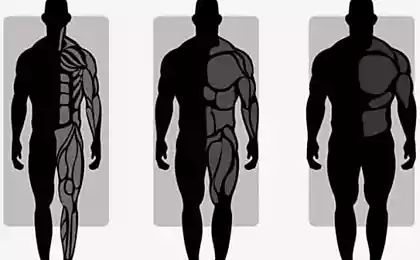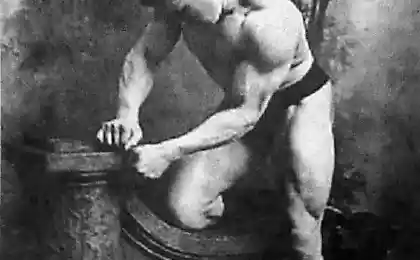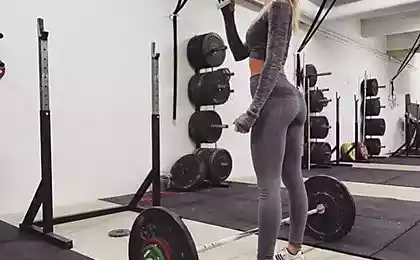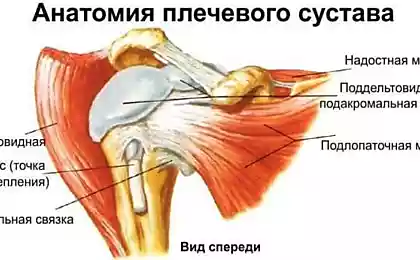219
10 major errors in the bench press
Lying down is the best exercise to make the upper body strong and muscular. But keep in mind that the wrong exercise technique can lead not only to wasted time in the gym. There is also a very high risk of serious injuries, such as a shoulder sprain or even a rupture of the pectoral muscles.
Experienced weightlifters pay great attention to this issue, because it depends on the correctness of the technique of bench pressing, which muscles will be involved in the exercise, and the effectiveness of your training in general. The following 10 bench press errors are the most common ones – especially, of course, beginners.
1. Improper elbow setting When executing the bench press, make sure that you do not withdraw your elbows to the sides. Removal of the elbows from the sides creates additional load and tension in the capsules of the shoulder and elbow joints. In addition, the correct setting of the elbows depends on the point of touching the body with the neck at the lower point of movement when the bar is approaching the chest. It should not fall on the collarbone, as this can lead to serious injury. The optimal position of the elbows when performing the bench press when you lower the bar is 45 degrees relative to your torso. This position will not only avoid injuries, but also better develop the pectoral and deltoid muscles, as well as triceps.
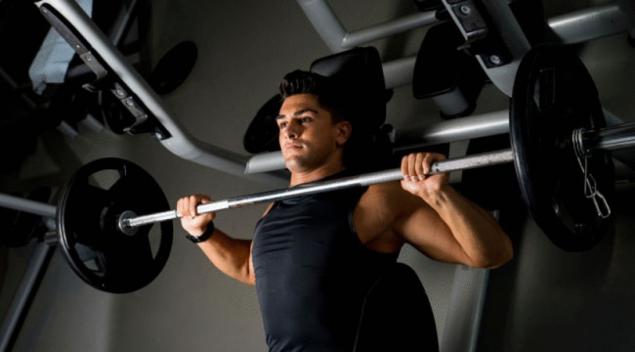
2. Beating the barbells Beating the bars against the chest at the bottom of the bench press is also a common mistake. This technique will not help you lift the barbell, but it is quite capable of injuring the chest, especially if you work with quite a lot of weight. If you are hitting a barbell, then most likely you have taken on a barbell that is too heavy for you. Remove the extra pancakes from it so that you can only slightly touch the body bar. Thus, touching it on the chest before the next lifting of the bar, you can both emphasize your strength and avoid injury.
3. Incorrect position of the shoulder blades To properly perform the bench press, it is not enough just to lie down and lift weight. You must firmly fix your body to adhere to the biomechanical parameters of the bench press technique as much as possible when pushing and lifting the barbell. Improper placement of shoulder blades will shift the load from the chest to the shoulders. And in order to expand the chest as much as possible, it is necessary to reduce the shoulder blades as much as possible, even if it causes pain or inconvenience.
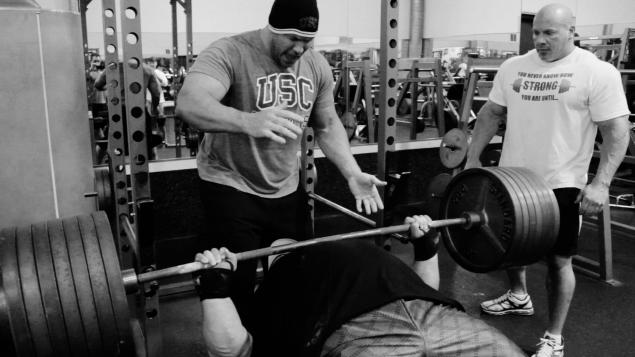
4. Self-removal of barbells from pillars When you yourself remove the bar to perform the bench press, it is very difficult not to change the correctly fixed position of the body. For example, it is unlikely that you will then be able to bend in the back correctly or reduce the shoulder blades as much as possible. And this, at least, can lead to stretching of the back muscles. Therefore, ask your partner to give you a barbell after you take the correct position on the bench. If you have no one to turn to for help, then adjust the holders of the bar so that when you remove it, you do not have to change the position of the body, or use the power frame.
5. Quick start. After you pick up the barbell, do not give in to the temptation to immediately lower it and start the exercise. Be sure to pause for a couple of seconds. This will allow you to better fix your body on a bench, ensure the stability of your abs and distribute the load to the whole body.
6. Not using the feet This error is most common in beginners who think that the legs when performing a bench press do not matter. In fact, it is quite the opposite: for the correct performance of this exercise, you need to firmly rest your feet on the floor to fix your position. And the more weight you take, the more you need to strain your quadriceps and buttocks.

7. Weakened wrists The next common mistake is falling back wrists. After all, how you grab the bar will determine the fate of not only your exercise, but also your wrists, elbows and shoulder joints. When performing a bench press, do not let your wrists bend backwards, keep the neck in the same plane with your forearms. For this, the position of the barbell in the hand should be closer to the wrist. “Load” the neck in the palm and grab it with your thumb. The wrist should be bent only a little.
8. Bending into the bridge Breaking the hips from the bench while performing the bench press will turn your body into a bridge. This may make it easier to do the exercise, but don’t do it. Thus, you put a tremendous load on your spine, which is very fraught with injuries to the lower back. Keep the buttocks on the bench very tightly, and bend only in the area of the thoracic spine and upper back, but not in the lower back.
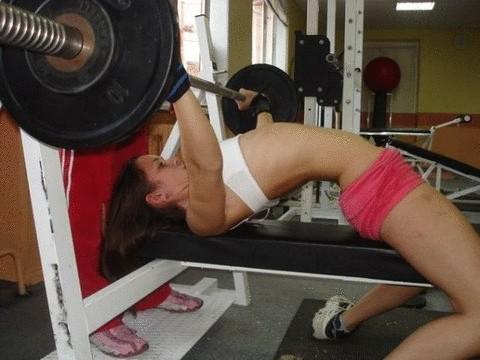
9. Heads off the bench There is nothing in the supine press that you need to turn your head for. Therefore, do not tear the back of the head from the bench while doing this exercise. Raising your head, you will only further strain the neck and weaken the press. In addition, you risk pinching the cervical vertebrae.
10. Incomplete amplitude of movement If you are lying down, lowering the bar, do not touch the chest, then deprive yourself of the maximum effectiveness of this exercise. This error is common to almost all beginners. Because of this, it is not possible to fully work out the muscles involved and achieve better results in less time. If you seek to get the maximum effect from the bench press, make sure that at each repetition of the exercise you touch the chest bar. published
Source: fitfixed.com
Experienced weightlifters pay great attention to this issue, because it depends on the correctness of the technique of bench pressing, which muscles will be involved in the exercise, and the effectiveness of your training in general. The following 10 bench press errors are the most common ones – especially, of course, beginners.
1. Improper elbow setting When executing the bench press, make sure that you do not withdraw your elbows to the sides. Removal of the elbows from the sides creates additional load and tension in the capsules of the shoulder and elbow joints. In addition, the correct setting of the elbows depends on the point of touching the body with the neck at the lower point of movement when the bar is approaching the chest. It should not fall on the collarbone, as this can lead to serious injury. The optimal position of the elbows when performing the bench press when you lower the bar is 45 degrees relative to your torso. This position will not only avoid injuries, but also better develop the pectoral and deltoid muscles, as well as triceps.

2. Beating the barbells Beating the bars against the chest at the bottom of the bench press is also a common mistake. This technique will not help you lift the barbell, but it is quite capable of injuring the chest, especially if you work with quite a lot of weight. If you are hitting a barbell, then most likely you have taken on a barbell that is too heavy for you. Remove the extra pancakes from it so that you can only slightly touch the body bar. Thus, touching it on the chest before the next lifting of the bar, you can both emphasize your strength and avoid injury.
3. Incorrect position of the shoulder blades To properly perform the bench press, it is not enough just to lie down and lift weight. You must firmly fix your body to adhere to the biomechanical parameters of the bench press technique as much as possible when pushing and lifting the barbell. Improper placement of shoulder blades will shift the load from the chest to the shoulders. And in order to expand the chest as much as possible, it is necessary to reduce the shoulder blades as much as possible, even if it causes pain or inconvenience.

4. Self-removal of barbells from pillars When you yourself remove the bar to perform the bench press, it is very difficult not to change the correctly fixed position of the body. For example, it is unlikely that you will then be able to bend in the back correctly or reduce the shoulder blades as much as possible. And this, at least, can lead to stretching of the back muscles. Therefore, ask your partner to give you a barbell after you take the correct position on the bench. If you have no one to turn to for help, then adjust the holders of the bar so that when you remove it, you do not have to change the position of the body, or use the power frame.
5. Quick start. After you pick up the barbell, do not give in to the temptation to immediately lower it and start the exercise. Be sure to pause for a couple of seconds. This will allow you to better fix your body on a bench, ensure the stability of your abs and distribute the load to the whole body.
6. Not using the feet This error is most common in beginners who think that the legs when performing a bench press do not matter. In fact, it is quite the opposite: for the correct performance of this exercise, you need to firmly rest your feet on the floor to fix your position. And the more weight you take, the more you need to strain your quadriceps and buttocks.

7. Weakened wrists The next common mistake is falling back wrists. After all, how you grab the bar will determine the fate of not only your exercise, but also your wrists, elbows and shoulder joints. When performing a bench press, do not let your wrists bend backwards, keep the neck in the same plane with your forearms. For this, the position of the barbell in the hand should be closer to the wrist. “Load” the neck in the palm and grab it with your thumb. The wrist should be bent only a little.
8. Bending into the bridge Breaking the hips from the bench while performing the bench press will turn your body into a bridge. This may make it easier to do the exercise, but don’t do it. Thus, you put a tremendous load on your spine, which is very fraught with injuries to the lower back. Keep the buttocks on the bench very tightly, and bend only in the area of the thoracic spine and upper back, but not in the lower back.

9. Heads off the bench There is nothing in the supine press that you need to turn your head for. Therefore, do not tear the back of the head from the bench while doing this exercise. Raising your head, you will only further strain the neck and weaken the press. In addition, you risk pinching the cervical vertebrae.
10. Incomplete amplitude of movement If you are lying down, lowering the bar, do not touch the chest, then deprive yourself of the maximum effectiveness of this exercise. This error is common to almost all beginners. Because of this, it is not possible to fully work out the muscles involved and achieve better results in less time. If you seek to get the maximum effect from the bench press, make sure that at each repetition of the exercise you touch the chest bar. published
Source: fitfixed.com
